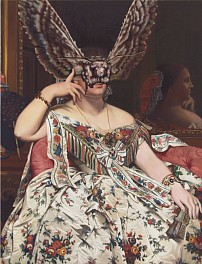BIOGRAPHY

Andrea Hornick’s work is historiographic and generative. It is at once playful and dead- serious, rooted in historic research and intuition. She employs nature-based spiritual practices that she learned as a child and has since deepened and honed. Contemporary issues are explored through bringing historical people and sites present for transformation.
Hornick re-paints Renaissance – early Modern portraits of women, altering them with the addition animal spirit guides. The source portrait is chosen for the sitter’s need for restoration of emotional and spiritual power. Societal imperfections of the woman were omitted to put forth the ideal. The idealized image is initiated by the sitter herself, framed by the male painter, and abetted by husbands, fathers, and benefactors, to deploy the portrait to burnish their reputations. Hornick researches the historical narrative of the sitter and circumstances of the painting of the source portrait. Then, in ritual, she seeks the animal that will help transform and alter the narrative, for transformational affect for the historical sitter, herself, the benefit of girls and women caught amidst structures of oppression, and the collective feminine. In technical fidelity to the source work, she strengthens her tutelage with the old master and brings forth their work’s aura. She works with conservators to determine the materials to which she stay faithful, as much as possible.
Text-based sound installation and performance elaborate upon the conflated historical and transformed narratives. The works are read epic poems that conflate narratives from art history and shamanic ritual to upend the perception of authorship and question the cannon. They are listened to in installations of her work to expand and illuminate the narratives generated in her painting process. Or, in existing museum collections, as in her 2017 Barnes Foundation exhibition, Unbounded Histories, the first contemporary piece to be included in the Barnes Foundation’s Collection Galleries. Hornick began learning shamanic drum journeying rituals from a shaman at age 9 and has since deepened and formalized her study and practice.
Abstract paintings loosely represent historic sites with visions of how present engagement with them can help transform the present.
Hornick has a B.A. from Oberlin College and an MFA from the San Francisco Art Institute. She is represented by Sears Peyton Gallery in New York and Los Angeles. Her 2017 museum exhibition at the Barnes Foundation was the first contemporary work in the Barnes’ Collection Galleries. Hornick has been exhibiting internationally since 1994. She has taught extensively since 2000 at Oberlin College and Barnard College, and since 2012, she has been teaching Fine Art and Architecture at the University of Pennsylvania.
